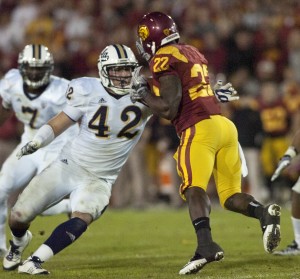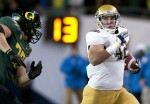
In a game with few bright spots for UCLA, Patrick Larimore gave the Bruins one of few memorable highlights. With his team trailing 7-0 in the 2011 Pac-12 Championship Game, the inside linebacker pounced on a pass deflected by Oregon running back Kenjon Barner for an interception. Sprinting up the sideline and avoiding a horse-collar tackle, Larimore vaulted himself into the end zone, scoring his first and last collegiate touchdown.
Even in a disappointing 2011 season for UCLA, he showed promise, leading the team in tackles and earning team Defensive Most Valuable Player honors. A team captain, it appeared Larimore had at least a shot at an NFL career, a destination he had spent the better part of his life pursuing.
In a few months, however, that dream came to a screeching halt.
With just over two weeks left until his final 12-week audition for the NFL was supposed to begin, the would-be redshirt senior linebacker called it quits. After years of building a reputation as a hard-nosed, blue-collar inside linebacker, the Santa Clarita native was forced into medical retirement due to yet another concussion, a product of being in the wrong place at the wrong time far too many times.
Even today, Larimore can’t pinpoint the exact number of concussions he’s received throughout his career. The national focus on post-concussion syndrome gained momentum during his upbringing in football, but what didn’t fade away was the inherent violence pinned to his position.
“There’s definitely been a couple of occasions where I’ve just been blasted,” Larimore said. “If somebody blasts you, then you get knocked … out. You need to be woken up. I don’t know if I could tell you how many concussions I’ve had because – looking back at high school, looking back at UCLA – I know the definition of what a concussion is has changed.”
From Hart High School to UCLA, the brutal, ill-timed hits began to mount, and by Aug. 6, 2012, he had received his sixth official diagnosis. Entering his fifth year at UCLA, he had seen the head trauma protocol before, but never the “16 or 17 symptoms” that consumed his life during a four-week stretch surrounding the team’s first stay in San Bernardino.
He preferred the dark, suffering intense sensitivity to light. He couldn’t sleep. His moods were constantly and dramatically changing, but that barely scratched the surface.
“I was definitely a different person, man,” Larimore said. “I was just depressed, suicidal, my thoughts were not coherent and there was no logic behind how I felt. Having that many symptoms persist longer than four weeks without changing really kind of woke (me) up. It made me say, ‘This is real, this is long-term stuff.’”
In his final days with the UCLA football team, Larimore sought the advice of both his parents and his team’s new coaching staff, including coach Jim Mora and linebackers coach Jeff Ulbrich. Despite only knowing his new superiors for a few months, Patrick saw them as “father figures” who never pressured him one way or the other. He especially looks back on his conversations with Ulbrich, who saw his ten-year NFL career with the San Francisco 49ers come to an end because of head injuries, with appreciation.
As the two sat in Larimore’s dorm room at Cal State San Bernardino, the dialogue was authentic and frank, with Ulbrich talking about the side effects he had experienced, ones that forced him to take off the pads and grab a whistle less than three years prior.
“Some of the effects I had from countless concussions, you know, I was able to tell him and I was honest,” Ulbrich said. “I treated him not like a piece of meat or a player that was going to feed my family. I treated him like I would treat my son in that situation. It was just perfect timing that I was here when that occurred, I think.”
For Larimore, a 253-pound linebacker who earned his bread at UCLA grabbing hold of speeding running backs and forcing them to the ground, one of the hardest parts was letting go.
With his mind made up and his team just informed of his decision, the rock of the linebacker corps couldn’t help but break as his comrades in the box said their goodbyes.
“When I first found out, I walked into his room and, as soon as I saw him, we both just broke down,” said fellow inside linebacker Jordan Zumwalt. “That’s a sad moment, especially for a guy like him. He is football. That’s what he stood for. That’s how we looked at Larry.”
Beyond just a few parting words, Larimore’s departure left behind a culture of playing in the moment and being able to walk off the field at the end of a game exhausted and without regret.
“It’s just an example of (taking ) one play at a time, because you never know when that last play is,” Zumwalt said. “For a guy like Larry to be able to lose it, it makes it so much more obvious to all of us that it could be lost to anybody.”
***
Not lost on Patrick Larimore is the want to help others and simultaneously grow from the toughest stretch of his life and, thanks to some unexpected inspiration, he can. Following an E:60 profile that brought Patrick’s story to the national stage in October 2012, he received a huge outpouring of responses from people all across the country who had seen their own lives altered by head injuries.
“Random people I didn’t even know were hitting me up on Facebook and telling me their stories and what happened to them,” Larimore said. “But they all had a different story and I think that led me to kind of create a platform or a place where they could share their take on it. And I think that hopefully that could provide some information and spread awareness.”
Aug. 26 marks the official launch of MyHeadHurts.co, a free website co-founded by Larimore, where athletes and non-athletes alike can share their head injury stories and build “support,” very similar to “likes,” with each person that reads their particular story. His hope is that the site becomes a safe space where people who are either still suffering or recently recovered can vent, find guidance and learn more about how to properly address and identify traumatic brain injuries.
Larimore also said he wants to continue to build a relationship with Boston’s Sports Legacy Institute, a non-profit organization devoted to the research of head trauma among athletes and how it can best be curbed. To start, he’s already written a blog post for USA Football, whose Heads Up campaign focuses on implementing safe tackling techniques and adequate concussion education in football leagues throughout the country. And as Larimore continues to grow from his experiences, so too do the site’s relationships.
On the site, the personal narratives range from the recollections of high school football players, hockey players and even a mom’s perspective on head trauma, most beginning with the opening “My head hurts because… .”
As Larimore keeps reaching out to former athletes, head trauma victims and organizations for potential partnerships, he can start to shape the supportive, cohesive community he originally envisioned in MyHeadHurts.
“I’ve been in touch with some of my former teammates that have had head injuries and they’re very interested in sharing (their stories) on there,” Larimore said. “I think that growing a network of players that can support each other from head injuries can be a very powerful way to start it.”
One story featured on the site is, of course, Patrick’s own. In it, he talks about his own lack of knowledge regarding head injuries before his experiences, the real, potentially fatal dangers he became exposed to, and his goals for the future of MyHeadHurts.
Though it appears Larimore’s darkest days are in the rear-view, it’s a story that is still far from over.
***
Just over a year removed from his medical retirement, it’s hard to say Patrick Larimore is over football.
His efforts in the community are intended to help so many, yet he’s without a part of his life that once consumed his every waking moment.
Morning practice, weights, meetings, food, film study, more food, sleep, repeat. In his four years on UCLA’s football team, this routine became his norm, allowing for an all-day, year-round football cycle that acted as an all-in-one full-time job, hobby and extracurricular activity.
“I can’t say I’m at peace with it,” said Larimore of his decision. “I miss football. Just being around it and all your teammates is something that kind of gets lost in things when you’re competing. I’m definitely not at peace with that.”
It’s an emptiness, a sense of incompleteness, that still makes him unable to watch football on TV. It’s a feeling that has made it very difficult for him to stay in contact with UCLA’s coaching staff, reminders of his former career.
“I haven’t talked to them in a little bit,” he said. “Football was such a big part of my life, but I imagine when the time is right for me, we’ll be in touch.”
Ulbrich said he was blindsided by that same feeling when his career with the 49ers came to an end. Even with a wife and kids to come home to, he felt something missing and was at a loss at not being able to use his remaining talents. For Larimore, he said, there’s a pain that stems from having his career cut short before knowing what could have been, how far he could have made it as a professional.
“All of a sudden, you’re just consumed by this sadness, and my therapy was getting into coaching, to be in it still and to feel it and to be around it,” Ulbrich said. “(Larimore is) not in that place yet. Essentially, he’s a guy that could’ve had a very long NFL career, and for that to be ended prematurely, it hurts, very, very badly.”
And while at heart Larimore knows he will always be a “Mike,” the tough-as-nails middle linebacker that anchors the defense and makes calls on the fly, he understands that the call he made in August of 2012 was the mature, responsible one. In a game that has progressed from a pinch of smelling salt here, holding up a few fingers there, a pat on the helmet and voila, to standard concussion testing protocols, he is an example of someone who had the foresight to recognize the lasting effects of continuing a risky career.
“That’s still something that’s in progress right now,” said Larimore of his health. “Getting better is something that I’m still working on every day.”
A 23-year-old with a UCLA diploma in hand and a community full of people to help, Larimore said he can finally “take some time to experience more things,” something he’s never been able to say before.
Change won’t be easy, however. The NCAA’s new targeting rule, aimed primarily at helping offensive players, has received plenty of criticism for its short notice and seemingly gray areas regarding “intent,” and football has long fostered the culture of throwback players where grit and toughness are respected and speaking out about being in pain is taboo.
“There’s no doubt, it’s what football breeds,” Ulbrich said. “The manly man who doesn’t share his feelings. We need to evolve beyond that. We really do.”
As long as Patrick Larimore has something to say about it, there’s a shot.

What a great article. Patrick is really a courageous young man. He made the right decisiion. The smart one. Good luck to you, Patrick!